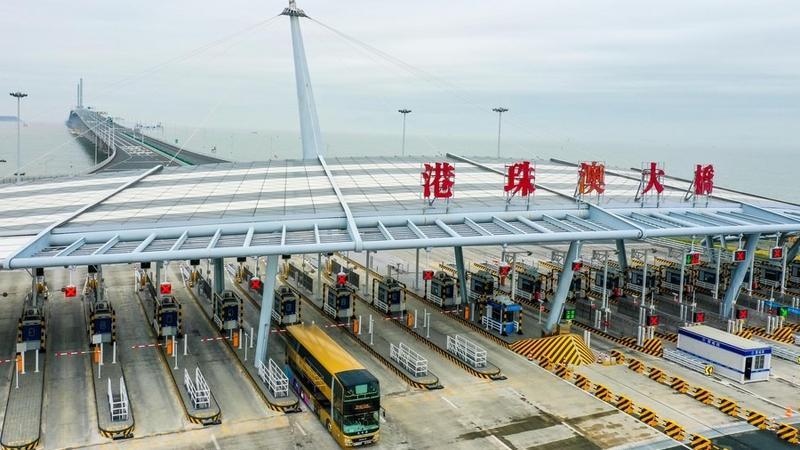 This photo dated Jan 8, 2023, shows a shuttle bus from Hong Kong entering Zhuhai through the Hong Kong-Zhuhai-Macao Bridge in south China. (PHOTO / XINHUA)
This photo dated Jan 8, 2023, shows a shuttle bus from Hong Kong entering Zhuhai through the Hong Kong-Zhuhai-Macao Bridge in south China. (PHOTO / XINHUA)
Government officials and industry experts said on Wednesday that Hong Kong’s logistics industry, with its untapped potential, requires policy innovation to reduce and eliminate unnecessary policy barriers hindering cross-boundary traffic, while emphasizing the importance to increase policy support and encourage the industry to embrace cutting-edge technology.
Delivering the opening remarks at the Logistics Summit 2023 hosted by the Logistics and Supply Chain MultiTech R&D Center (LSCM), Leung Chun-ying, vice-chairman of the National Committee of the Chinese People’s Political Consultative Conference, said he believes that from the “hardware side”, transportation between Hong Kong and other cities in the Guangdong-Hong Kong-Macao Greater Bay Area has been “quicker, easier and cheaper”, but there’s still a need to address policy-related obstacles.
To encourage the adoption of technology by the logistics sector, the government launched the Pilot Subsidy Scheme for Third-party Logistics Service Providers in October 2020
Citing the 14th National Five-Year Plan’s (2021-25) support for the Hong Kong Special Administrative Region to upgrade its status as an international financial, trade and transportation center, Leung said the key word is “upgrade”, not “expand”.
READ MORE: How Hong Kong plays it smart in transport and logistics
To achieve an “upgrade”, he said, “All the rigid and unnecessary policy barriers impeding cross-boundary traffic should be lowered or removed altogether using the latest technologies while complying with the ‘one country, two systems’ principle.”
Leung views the co-location arrangement at the West Kowloon Station of the high-speed rail network as a prime example, not only for its convenience to passengers but also for showcasing Hong Kong’s capacity, under the “one country, two systems” principle, to undertake policy innovations in managing cross-boundary transportation.
“Following the practice, I cannot see any reason why we cannot have similar co-location arrangements for other cross-boundary traffic,” said Leung.
He said he was perplexed by the practice requiring vehicles, including lorries, to obtain new license plates before they can be driven across the boundary, saying “If a Hong Kong driver holding an international driving license can drive in foreign countries without having to take a local driving test, why isn’t a similar arrangement available in the Guangdong cities of the Greater Bay Area? Chinese mainland drivers face the same situation in Hong Kong, Leung added.
Against the backdrop that “the global logistics industry is heading towards (becoming) smarter, more competitive and innovative through specialization and digitalization”, Permanent Secretary for Transport and Logistics Mable Chan said that the SAR government is working closely with the LSCM and the Hong Kong Productivity Council to boost policy support in a bid to “meet the short-, medium- and long-term development needs of the international logistics center”. “The action plan will be announced very soon, so stay tuned,” Chan said.
READ MORE: HK considers setting up logistics park in Zhuhai
To encourage the adoption of technology by the logistics sector, the government launched the Pilot Subsidy Scheme for Third-party Logistics Service Providers in October 2020. She said, “More than 170 logistics enterprises have benefited from this scheme, with approved funding amounting to over HK$120 million ($15.35 million) by now.”
Chan added that the GBA provides a huge market for logistics development, thus “it is crucial for us to make good use of Hong Kong’s institutional strength, international outlook, prime geographical location, and especially professional talents, to provide more modern logistics services to the Greater Bay Area and complement the strength of other cities”.
Leung highlighted the complementary roles played by the GBA’s airports, when recalling his experience of flying to Cairo from Guangzhou two weeks ago, as there are no direct flights from Hong Kong to Cairo.


